New technologies could keep people cool in a warming world
The goal is to protect people from extreme heat without worsening greenhouse-gas emissions

People around the world will experience more days of extreme heat as climate change continues. Without ways to stay cool, those days will be uncomfortable at best. At worst, excessive heat will threaten people’s lives.
Andrew Merry/Moment/Getty Images Plus
This is another in a new series identifying technologies and actions that can slow climate change, reduce its impacts or help communities cope with a rapidly changing world.
Power outages shut down air conditioning for hundreds of thousands of people in Ohio last summer. Temperatures in Columbus on June 14 hit 34° Celsius (93° Fahrenheit). Overnight, temps didn’t get cooler than 25 °C (77 °F). As a result, homes stayed hot and stuffy. Climate change made that hot night more likely than it would have been otherwise, according to a data tool used by Climate Central. That’s a nonprofit news group that analyzes and reports on climate science.
But Ohio’s conditions were balmy compared to what many have faced elsewhere. In March 2021, temperatures soared to 49.5 °C (121.1 °F) in Nawabshah, Pakistan. In June of that year, temps climbed to 49.6 °C (121 °F) in one town in Canada’s British Columbia. And July heat in parts of China and England last year topped 40 °C (104 °F).
Many folks hit by these hot spells had no air conditioning. People in parts of England and the Pacific Northwest, for instance, had seldom seen any need for it.
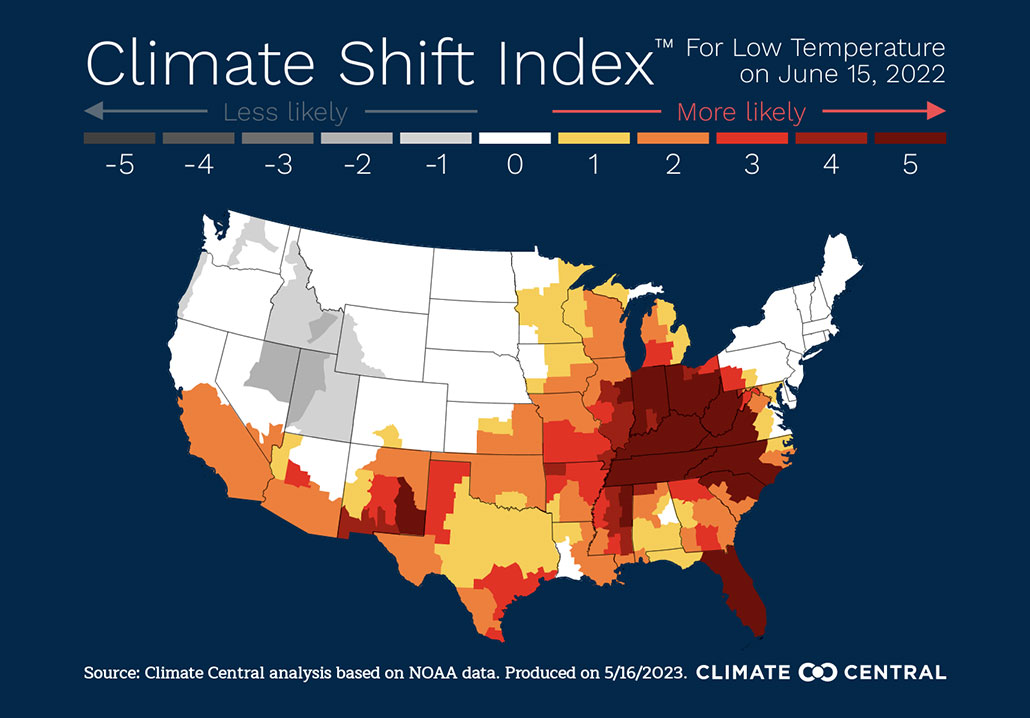
As Earth’s climate continues to warm, people around the world are facing more very hot days. Extreme heat can worsen health problems — and sometimes prove deadly. Hot weather also makes it hard for people to work effectively. So it’s no surprise that in a warming world, many more people will want — and need — ways to stay cool.
Yet extra electricity for more air conditioning could strain the electric power grid. Some places in the United States could see more rolling power blackouts, warned a January 2022 report in Earth’s Future.
Rohini Kumar is a coauthor of that study. He works at the Helmholtz Centre for Environmental Research–UFZ in Leipzig, Germany. Most people in the United States already have air conditioners, or A/C, Kumar notes. But in many other parts of the world, such as India, few people have A/C at home. Adding A/C there would boost electricity use. Right now, only coal, oil or gas can provide enough electricity for that. Those fuels emit a lot of greenhouse gases, which drive climate change.
Each year, energy for cooling already spews some 1.95 billion metric tons (2.15 billion short tons) of greenhouse gases into the atmosphere. That’s almost 4 percent of global emissions, researchers reported April 2022 in Joule. What’s more, many of today’s A/C systems use heat-absorbing fluids called coolants, which are themselves greenhouse gases. Those gases can leak out of A/C units into the atmosphere.
Engineers are working on new, better ways to cool off. Some of these A/C systems would run on less electricity and get rid of environmentally harmful coolants. Other innovations would help keep summer heat out of buildings, no electricity needed. The emerging options range from high-tech to simple. But they could all soon help people around the world better cope with our warming Earth.
Today’s cooling technology is old-school
The technology behind today’s air conditioners is more than 100 years old. Most homes and buildings now use a central unit, which supplies cool air to all or major parts of an entire building. Air inside the building sheds heat to a coolant in the system. Heat pumps use similar concepts for cooling in the summer. In cold weather, a heat pump reverses this process. It pulls some heat from the outside air and moves it inside. Heat pumps are generally more efficient than the combination of standard air conditioners and furnaces.
New approaches to evaporation
Mechanical engineer Eric Kozubal works at the National Renewable Energy Laboratory in Golden, Colo. He was an author of the April 2022 Joule study. His group found that more than half of the greenhouse gases linked to today’s A/Cs comes from producing the energy to power them. Most of the rest come from their coolants. A smaller share comes from manufacturing the air conditioners.
A/C systems move heat out of buildings through evaporative cooling. Basically, when a liquid evaporates, the resulting vapor can carry away heat. This is the same process that makes you feel cold when you get out of a pool and water evaporates off your skin. Today’s A/C units do evaporative cooling with greenhouse gas coolants. But Kozubal’s team has designed a new system that does evaporative cooling with salty water.
The new design doesn’t just do away with polluting coolants. It could also cool air much more efficiently. Why? Because the new setup uses its salt water to dry out the air it’s cooling. Salts in the water, such as lithium chloride or potassium acetate, soak up humidity from the air. And evaporative cooling is much easier to do with dry air. You may have experienced this yourself. Think about how you can shiver coming out of a pool into dry air, even when it’s hot outside, Kozubal says. You get chilly much faster than you would in the humid air of an indoor pool.
The new system could cool air using only a sixth as much electricity as standard A/C units, Kozubal says. Just how much energy it needs will depend on how humid a local area is. Blue Frontier, a company based in Parkland, Fla., is looking to bring this technology to market.
Another new cooling technology uses water as its coolant instead of fluids that act like greenhouse gases. Jack Alvarenga works at Harvard University in Cambridge, Mass. This materials scientist was part of a team that invented the new system. It moves incoming air through a series of porous ceramic tunnels.
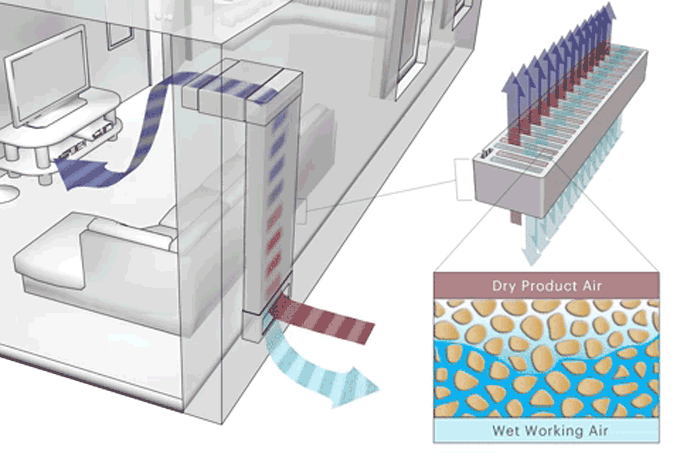
The system sprays water onto half of the tunnels. The ceramic absorbs some of that water. Heat in those tunnels evaporates the water. That cools off those tunnel walls. Excess humidity from those tunnels then goes outside.
Other tunnels have a barrier layer that keeps water out. Air passing through them stays dry. But that air also cools down because the dry tunnels sit next to the ones that got sprayed and cooled off.
The team tested the system in July 2022 at a house in Cambridge, Mass. Despite a heat wave, this system lowered a room’s temperature by about 10 degrees C (18 degrees F). “We’re still trying to improve” that number, Alvarenga says. And the system used less energy with no greenhouse-gas coolants.
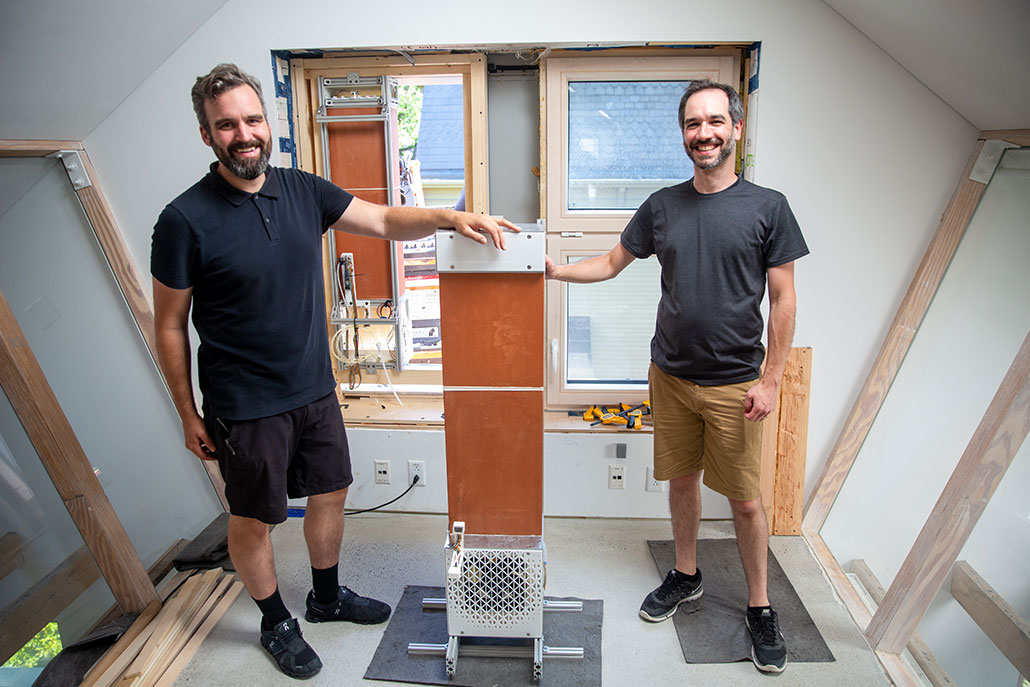
Solids that cool
Barocaloric (BAIR-oh-kah-LOR-ik) materials might also be useful new tools to beat the heat. These nifty materials release or absorb heat in response to pressure changes. Putting pressure on barocaloric materials makes their molecules more ordered. This makes the materials release energy in the form of heat. On the flip side, the molecules in these materials become more disordered when pressure on them lets up. In the process, the molecules absorb energy and cool the space around them.
Jarad Mason is an inorganic and materials chemist at Harvard who works with these materials. The substances include some types of crystals known as perovskites (Per-OV-skytes). Mason’s group found a way to make perovskites release or absorb energy at tens or hundreds of bars of pressure, versus thousands. (One bar is the average air pressure at sea level.) Among other things, the group’s new design uses two-dimensional perovskites, rather than 3-D chunks of the crystals. The group shared its design in the May 2022 Nature Communications.
“We think we can make devices that … can be used for both heating and cooling,” Mason says. Devices called heat pumps do that now. But applying and releasing pressure on barocaloric materials would probably take less energy than current heating and cooling systems, Mason says. As a result, new devices made with perovskites would likely need less electricity. Plus, they wouldn’t use environmentally harmful coolants. Now, the researchers are working to boost the materials’ cooling efficiency.
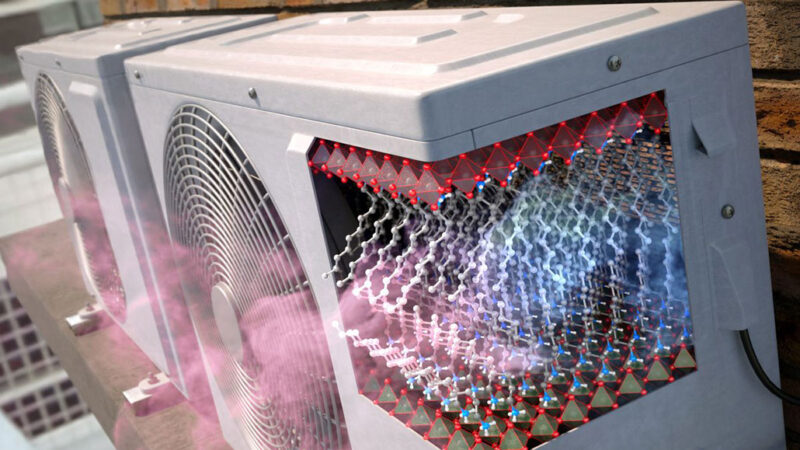
“We think our technology will be competitive” — cost about the same — as today’s standard A/C, Mason says.
Other materials are magnetocaloric (Mag-NEE-toh-kah-LOR-ik). That means they can change temperature in response to a magnetic field. Inside a magnetic field, a magnetocaloric material’s molecules all line up. That temporarily releases energy, and the material heats up. A pause then lets the material’s temperature adjust to the area around it. When the material is removed from the magnetic field, its molecules get jumbled up again. As they become disordered, the material absorbs heat from the air around it.
Different rare-earth elements, such as gadolinium, are magnetocaloric. Turning on or off magnetic fields around them — and at just the right time — would provide bursts of cooling. Water pumped around the material could carry away heat absorbed by the materials’ jumbled up molecules.
“It’s really interactions between these materials and the magnetic field that underpin the effect,” according to Vitalij Pecharsky. A materials scientist, he worked at the Ames National Laboratory and Iowa State University in Ames.
Cooling systems made with magnetocaloric materials should need about one-third less energy than today’s A/Cs to cool air, he said.
“We know how to engineer the device,” Pecharsky told Science News Explores. But magnets with strong enough magnetic fields to do this are expensive. “If we can design better materials that can work in a lower magnetic field, that is going to [lower] the cost.”
Passive cooling
Barocaloric coolers would need electricity to pressurize the materials. And magnetocaloric coolers would also need electricity to power their magnetic fields. Some other cooling strategies won’t need any electricity at all. These strategies are called passive cooling techniques.
For instance, a new window coating can keep out warming sunlight. The coating lets in visible light but blocks ultraviolet and infrared light. Light in those wavelengths cannot be seen. But infrared light can be felt as heat. And ultraviolet light causes sunburns. The new window covering also radiates heat away from a window at a wavelength that can move through the air and into space. All of this helps keep air indoors relatively cool.
Researchers in Great Britain have developed another, double-duty window coating. In hot weather, it would block near-infrared waves, which carry heat. In cold weather, it would let those waves pass through a window to heat the indoors. At all times, the windows remain transparent to visible light. The team described its work last December 17 in ACS Photonics.
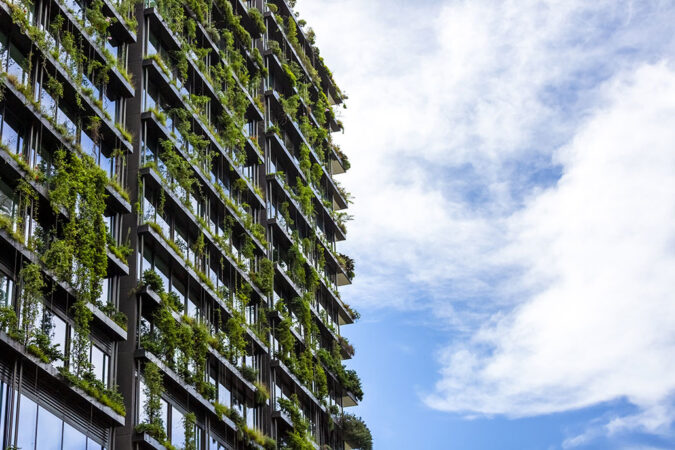
Other cooling approaches are designed for roofs and walls. For instance, Beta Paramita investigated how a simple coat of paint could help keep buildings without A/C cool. Paramita is an architectural engineer at the Indonesia University of Education in Bandung.
Light colors reflect the sun’s warming rays better than darker colors do. So before and after painting dark roofs a light color, Paramita’s team measured a building’s temperature. They found that, depending on what a roof was made of, a lighter color could leave the living space under it nearly 5 degrees C (about 8 degrees F) cooler than before.
This project, known as Cool Roofs Indonesia, impressed judges of the 2022 Clean Cooling Collaborative’s Million Roofs Challenge. Paramita’s group took home first place — and a $750,000 prize.
Most people who participated in Paramita’s experiment felt cooler after their roof was painted a light color. Some said their children also breathed easier at night. Electricity bills even went down by about 10 percent in some homes because people did not run their fans as often.
Oladunni Izobo-Martins is an architectural researcher. She works at Redeemer’s University in Ede, Nigeria. Using light colors was one of several things she and others assessed as they reviewed newer shopping malls in the southwest of her country.
The team focused on four malls, only two of which made good use of light colors. Most had some shading on the roof or from overhangs. But they had little or no insulation or windows that opened. And few had shady trees and shrubs nearby. The team shared its findings at an October 2021 conference in Ota, Nigeria.
Architects often focus more on a building’s looks, Izobo-Martins says — not on its use and upkeep. “We should think about the maintenance. We should think about the effects on the people.” A/C is pricey, so passive cooling should be harnessed wherever possible, she says. It can cut the fossil-fuel use that drives climate warming.
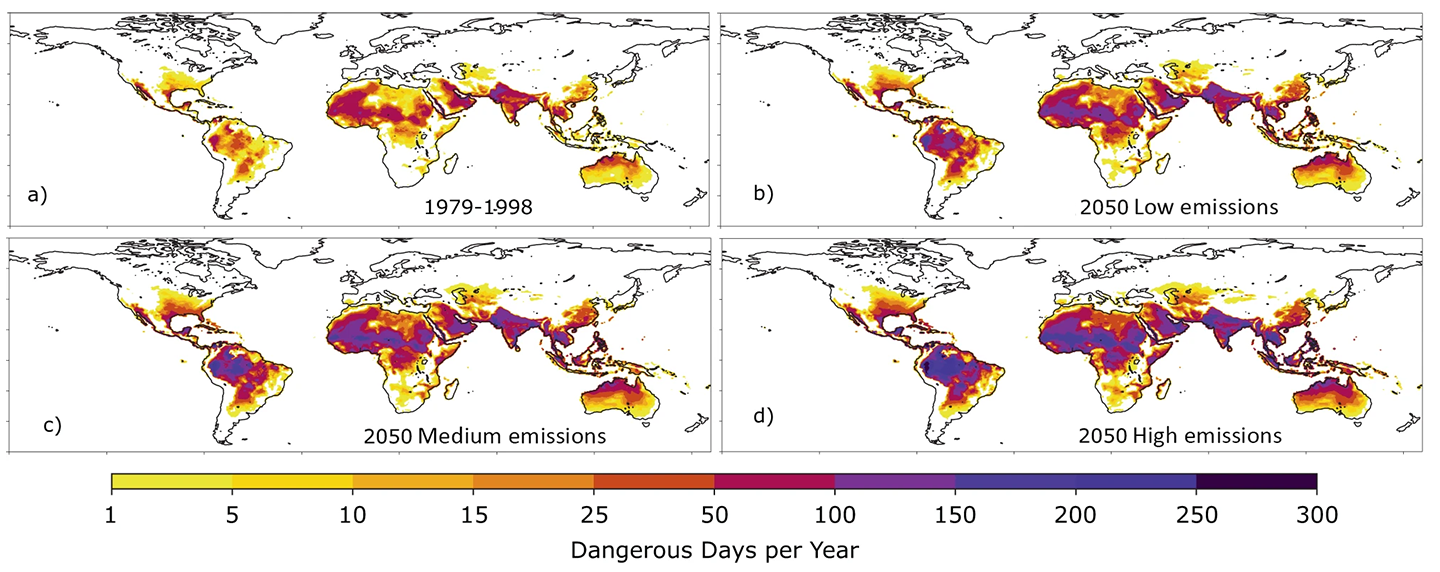
By 2050, most of Nigeria will face more than 50 additional days of dangerous heat each year. On those days, the combination of heat and humidity will make it feel like the temperature is above 39.4 °C (103 °F). And this problem will not plague only Nigeria. Worldwide, the number of days with dangerous heat by the end of this century will likely go up three to 10 times.
To cope with our warming world, it’s important to “think outside the box,” says Alvarenga at Harvard. After all, he points out, solutions don’t have to be “one-size-fits-all.”







